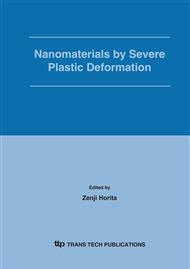[1]
B.E. Warren: Progr. Metal Phys. Vol. 8 (1959), p.147.
Google Scholar
[2]
M.A. Krivoglaz: Theory of X-ray and Thermal Neutron Scattering by Real Crystals (Berlin: Springer-Verlag, 1996).
Google Scholar
[3]
E.J. Mittemeijer and P. Scardi, Eds: Diffraction Analysis of the Microstructure of Materials (Berlin: Springer-Verlag, 2004).
Google Scholar
[4]
T. Ungár: Scripta Mater. Vol. 51 (2004), p.777.
Google Scholar
[5]
T. Ungár, P. Martinetto, G. Ribárik, E. Doryhée, Ph. Walter and M. Anne: J. Appl. Phys. Vol. 91 (2002), p.2455.
Google Scholar
[6]
P. Scardi, M. Leoni and Y.H. Dong: Mat. Sci. Forum, Vol. 378-381 (2001), p.132.
Google Scholar
[7]
T. Ungár, J. Gubicza, G. Ribárik and A. Borbély: J. Appl. Cryst. Vol. 34 (2001), p.298.
Google Scholar
[8]
P. Scardi and M. Leoni: Acta Cryst. Vol. 58 (2002), p.190.
Google Scholar
[9]
M. Wilkens: Fundamental Aspects of Dislocation Theory, ed. J.A. Simmons, R. de Wit, R. Bullough (Vol. II. Nat. Bur. Stand. US Spec. Publ. No. 317, Washington, DC. USA, 1970) pp.1195-1221.
DOI: 10.6028/nbs.sp.317v1
Google Scholar
[10]
M.M.J. Treacy, J.M. Newsam and M.W. Deem: Proc. Roy. Soc. London A, Vol. 433 (1991), p.499.
Google Scholar
[11]
L. Balogh and T. Ungár: (2005) in preparation.
Google Scholar
[12]
T. Ungár, E. Schafler, P. Hanák, S. Bernstorff, and M. Zehetbauer: Z. Metallkde. (2005) in press.
Google Scholar
[13]
G. Tichy and T. Ungár: (2005) in preparation.
Google Scholar
[14]
G. Stagika, S. Ichtiaroglou, I. Groma, F. F. Csikor, and E. Aifantis, J. Mech. Behav. Metals, Vol. 14 (2003), p.1.
Google Scholar
[15]
G. Caglioti, A. Paoletti and F.P. Ricci: Nucl. Instruments, Vol. 3 (1958), p.223.
Google Scholar
[16]
T. Ungár and G. Tichy: phys. stat. sol. (a), Vol. 171 (1999), p.425.
Google Scholar
[17]
T. Ungár, I. Dragomir, Á. Révész and A. Borbély: J. Appl. Cryst. Vol. 32 (1999), p.992.
Google Scholar
[18]
I.C. Dragomir and T. Ungár: J. Appl. Cryst. Vol. 35 (2002), p.556.
Google Scholar
[19]
G. Ribárik, T. Ungár and J. Gubicza: J. Appl. Cryst. Vol. 34 (2001), p.669.
Google Scholar
[20]
I.P. Jones and W.B. Hutchinson: Acta Met. Vol. 29 (1981), p.951.
Google Scholar
[21]
K. Máthis, K. Nyilas, A. Axt, I.C. Dragomir, T. Ungár and P. Lukáč: Acta Mater. Vol. 52 (2003), p.2889.
DOI: 10.1016/j.actamat.2004.02.034
Google Scholar
[22]
Y.T. Zhu, J.Y. Huang, J. Gubicza, T. Ungár, Y.M. Wang, E. Ma and R.Z. Valiev: J. Mater. Res. Vol. 18 (2003), p. (1908).
Google Scholar
[23]
G. Ribárik, J. Gubicza and T. Ungár: Mater. Sci. Eng. (A) Vol. 387-389 (2004), p.343.
Google Scholar
[24]
W. C. Hinds: Aerosol Technology: Properties, Behavior and Measurement of Airbone Particles (New York: Wiley, 1982).
Google Scholar
[25]
R. J. Hellmig, S. C. Baik, R. J. Bowen, Y. Estrin, D. Juul Jensen, H. S. Kim and M. H. Seo: Fundamentals Processing, Applications - NanoSPD2 (J. Wiley VCH Weinheim, 2004), p.257.
Google Scholar
[26]
A. P. Zhilyaev, J. Gubicza, G. Nurislamova, Á. Révész, S. Suriñach, M. D. Baró, and T. Ungár: phys. stat. sol. (a), Vol. 198 (2003), p.263.
DOI: 10.1002/pssa.200306608
Google Scholar
[27]
R. Mitra, T. Ungár, T. Morita, P. G. Sanders and J. R. Weertman: in Advanced Materials for the 21st Century, (Eds. Y.W. Chung, D.C. Dunand, P.K. Liaw, G.B. Olson, TMS, Warrendale, USA, 1999), p.553.
Google Scholar
[28]
E. Schafler, G. Steiner, E. Korznikova, M. Kerber and M. J. Zehetbauer: Mater Sci. Eng. (A) (2005) accepted for publication.
Google Scholar
[29]
T. Ungár, E. Schafler, P. Hanák, S. Bernstorff, and M. Zehetbauer: Z. Metallkunde (2005) accepted for publication.
Google Scholar
[30]
E. Schafler, K. Simon, S. Bernstorff, P. Hanák, G. Tichy, T. Ungár, M.J. Zehetbauer: Acta Materialia, Vol. 53 (2005), p.315.
DOI: 10.1016/j.actamat.2004.09.025
Google Scholar
[31]
A. Seeger, Handbuch der Physik III. (Springer-Verlag, Berlin, 1955).
Google Scholar
[32]
I. Kovács, Acta Metall. Vol. 15 (1967), p.1731.
Google Scholar
[33]
M. Zehetbauer, Key Eng. Mater., Vol. 97-98 (1994), p.287.
Google Scholar
[34]
G. Saada, in Electron Microscopy and Strength of Crystals, eds. G. Thomas & J. Washburn, (New York, Interscience, 1963).
Google Scholar
[35]
H. G. Van Bueren, Acta Metall. Vol. 3 (1955), p.519.
Google Scholar


